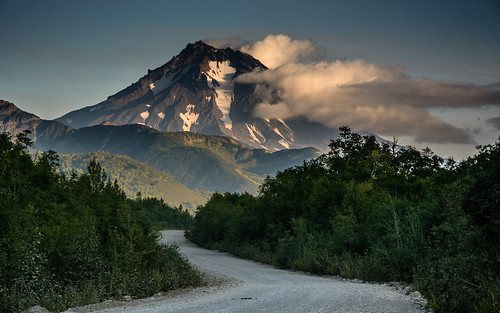Photo courtesy of kuhnml Flickr Page (Volcano Vilyuchinsky in Russia): https://www.flickr.com/photos/31176607@N05/16741017707
Creative Commons License: https://creativecommons.org/licenses/by/2.0/
In the late winter/early spring of 1997, I began to fully appreciate the might of volcanoes for the first time ever.
That came after watching Dante's Peak. That, of course, was a fictional account of the very real possibility of some volcano erupting again in the Pacific Northwest, much like Mount St. Helen's actually did in real life back in May of 1980.
A few months after watching that movie, my girlfriend (now ex-wife) and I went to Seattle to visit with her brother, who had moved there earlier in the year.
What I had in mind in going there were the clubs and music scene that had exploded into fame some years earlier, with bands that I really enjoyed and easily identified with. Bands like Pearl Jam, Nirvana, Alice in Chains, Soundgarden, the Screaming Trees, and a few others. Also, some other bands not with the whole "grunge" thing, such as Queensryche and Heart. Of course, I also knew about the Space Needle, and hoped that we could go up there.
But what I was not expecting was the sheer natural beauty evident from the city of Seattle itself. Sure, there must be natural beauty well outside of the city, but surely it would not be in view from Seattle itself, right?
When we got there, it was nighttime, and we drove by the city skyline. Caught my first glimpse of the Space Needle, as well as the Kingdome (since defunct). But other than driving by the city, we went back to her brother's house and settled in for the night, since it was quite late.
The next morning, however, I remember stepping outside of the house for the first time in daylight. What I saw was stunning! It was a beautiful, sunny day (it would be like that all week during our stay), and as clear as likely could be. I looked to the right, and saw the snow-capped mountains of the Cascades to the east. To the west, I saw the rugged peaks of the Olympic Mountains, also capped with snow, as they rose over Puget Sound. With all of the rain that Seattle gets, the grass and trees were a vibrant green. Later, we saw the majestic peak of Mount Rainier rising over the city from some seventy or so miles outside of town!
There is no denying that mountains are all over the Pacific Northwest, and they are beautiful! It makes for some incredible and inspiring scenery. One local told me that it made him feel like he was always on vacation, seeing the mountains like that on a daily basis. Yes, they get a lot of rain in that region, and there is no denying that. However, most everyone there seemed to suggest that the three or so months of clear weather in the summer make the other nine months of constant grey and drizzle worth it.
Here's the thing, however: that beauty comes at a cost. All of that beauty can be dangerous, because those peaceful, towering mountains also happened to be a volcanic range. That possibility hit home nationally, of course, when St. Helen's blew up. It was the first time in modern history that a volcano erupted in one of the lower 48 states.
The movie Dante's Peak served as a reminder for me, because I could barely remember the eruption in 1980, since I was not even six years old yet at the time. I vaguely remember something about it, but it is very, very sketchy. Certainly, it cannot be said that I could recall it in any great detail, or that I understood what was going on.
But when we went to Washington, there were quite a few reminders, and some natives could recall the eruption (although a lot of people in the state, and particularly in Seattle, are from out of state, so their experience was quite different and likely more detached).
There was a lot of discussion about volcanoes during that trip. At the top of the Space Needle, there was an exhibit on volcanoes, and from the viewing deck, it was made clear all of the volcanoes surrounding the area.
I got a book about volcanoes, purchased a DVD copy of Dante's Peak, and watched it numerous times, more fascinated by now than ever before. There were searches on the internet. It became sort of an obsession for a little while.
The thing is, the United States does not even have it as bad as other countries. There are volcanoes in the Pacific Northwest, but the most dangerous volcanoes in the continental United States are in Alaska. If you take Hawaii into consideration, there are some active volcanoes that can be seen and learned from as well.
But the deadliest volcanoes that pose the most immediate problems are actually in another part of the so-called "Ring of Fire" around the Pacific Ocean. Those would be in Indonesia and the Philippines, although these are certainly not the only nations in real danger with volcanoes.
Also, it should be noted that there are a few truly deadly volcanoes that, if they should ever erupt, could disrupt life as we know it here on Earth. Two of them are inside of American borders. One is in California, and the other is under Yellowstone National Park.
Below are links to more articles on volcanoes. The first is an article about the 10 nations most threatened by volcanoes. The next is an article about Yellostone's supervolcano, and the likelihood (or lack thereof) that it will ever actually erupt. Here are the links:
10 Most Hazardous Countries For Volcanoes (Photos) by Becky Oskin, senior writer for Live Science, April 10, 2015:
http://www.livescience.com/50451-10-hazardous-countries-volcanoes.html?cmpid=514627_20150411_43621536&adbid=10152678073431761&adbpl=fb&adbpr=30478646760
Will the Yellowstone Volcano Erupt? By: Brian Allen, Jan 29, 2015:
Will the Yellowstone Volcano Erupt? By: Brian Allen, Jan 29, 2015:

No comments:
Post a Comment